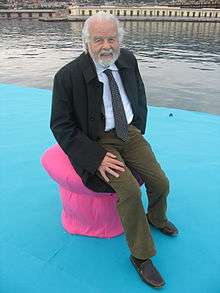Paolo Budinich
Paolo Budinich (28 August 1916 – 14 November 2013) was a theoretical physicist. Born from a sailors' descent from Lussingrande, grew up and studied in Trieste, where the family resided, because the father Antonio Budini[1] taught in the local High School, the same where Paolo Budinich got his grade in 1934. He later started his study course at Università Degli Studi di Pisa graduating at the Scuola Normale Superiore in 1938,[2] with a thesis written under the direction of Leonida Tonelli.[3]
Paolo Budinich | |
|---|---|
 Paolo Budinich in Trieste, 2007 | |
| Born | 28 August 1916 Lussingrande, Italy |
| Died | 14 November 2013 (aged 97) Trieste, Italy |
| Nationality | Italian |
| Alma mater | University of Pisa Scuola Normale Superiore di Pisa |
| Scientific career | |
| Fields | Theoretical physics |
| Institutions | International Centre for Theoretical Physics International School for Advanced Studies |
| Doctoral advisor | Leonida Tonelli |
In the same year he started to teach physics on the Italian training ship Amerigo Vespucci, belonging to Italian Naval Academy of Leghorn.
During Second World War he served as Lieutenant on Navy submarines and observer on Navy planes; in 1941 Budinich was caught prisoner by the Royal Navy and became a prisoner of war, thus being transferred to England and then to the United States.
Back to Physics, in 1952 he worked with Werner Heisenberg in Göttingen and in 1954 with Wolfgang Pauli in Zürich.
He was one of the first promoters of Trieste as a science resort at international level. In 1964 he founded in Trieste, together with Abdus Salam, the International Centre for Theoretical Physics (ICTP). In the same year he promoted the Advanced School of Physics, that in 1978 was upgraded to the International School for Advanced Studies (SISSA), which was the first Italian higher education institution providing doctoral degrees (besides Scuola Normale Superiore in Pisa), and became its first director.
In his autobiography L'arcipelago delle meraviglie, published in 2000, Budinich pleads for a reunification between science and philosophy and suggests a superior capability of mathematics to disclose unknown scientific discovery paths. His main work, The Spinorial Chessboard, written together with the Polish mathematical physicist Andrzej Trautman, refers to Élie Cartan's conceptual foundation of spinor geometry and explores its applications to modern physics.
Bibliography
- Paolo Budinich, L'arcipelago delle meraviglie, Beit casa editrice, Trieste 2016, ISBN 978-88-95324-50-0.
- Paolo Budinich and Andrzej Trautman, The Spinorial Chessboard, Springer Verlag, Berlin-New York 1988, ISBN 9783540190783.
Note
- In 1937, during Fascism, the family name was Italianised in “Budini”; it was restored to the original spelling in 1977.
- from ictp.trieste.it Archived 2009-08-11 at the Wayback Machine
- Paolo Budinich at the Mathematics Genealogy Project
Further reading
- Pietro Greco and Federica Manzoli, Buongiorno Prof. Budinich. La storia eccezionale di un fisico italiano, Bompiani, 2007, ISBN 9788845258206.
- Rita Cian, Paolo Budinich. Sea, science and adventure in the life of a Theoretical Physicist, Maqom Hazè, Trieste 2014, ISBN 9788898946020.